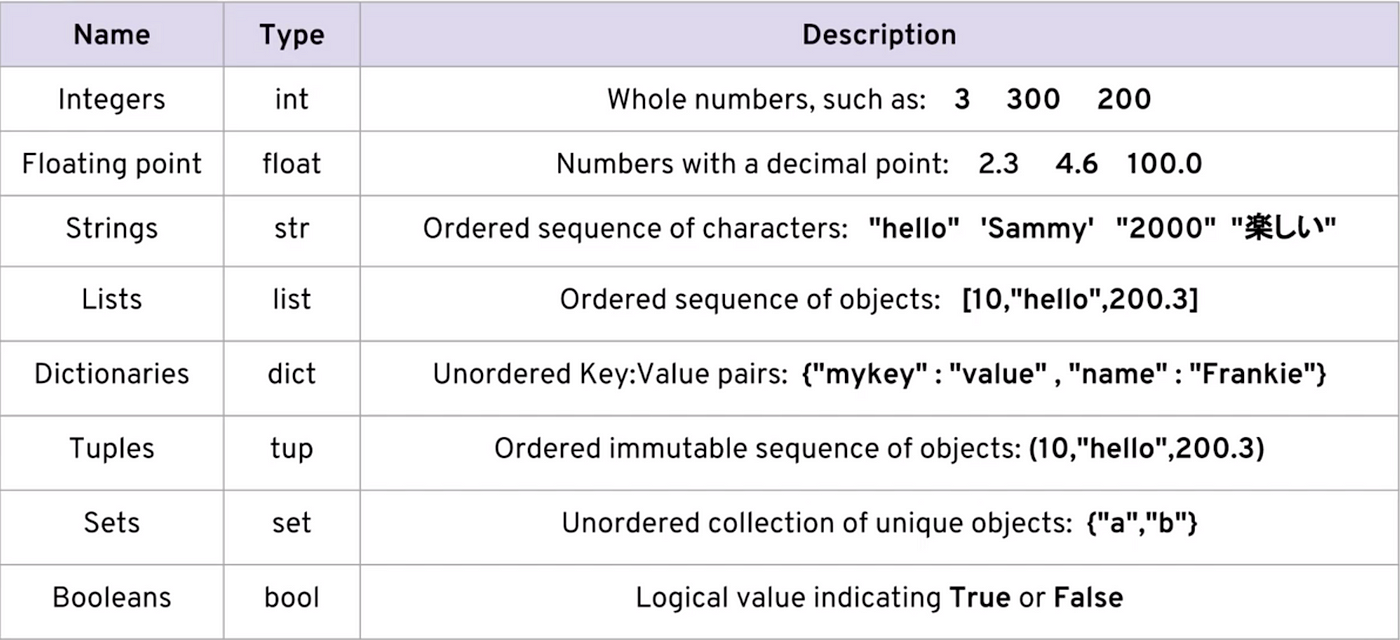What are Data Types in Python | All Data Types | Tutorial For Beginners
What are Data Types in Python | All Data Types | Tutorial For Beginners
In Python, data types are used to classify one particular type of data, determining the values that you can assign to the type and the operations you can perform on it. Some common data types in Python are:
Integer: This is a whole number, positive or negative, without a decimal point. For example: -10, 0, 100.
Floating point: This is a number with a decimal point. For example: 3.14, -0.001, 0.0.
String: This is a sequence of characters enclosed in single or double quotes. For example: 'hello', "world", "123".
List: This is an ordered collection of items, which can be of different types. Lists are created using square brackets [] and the items are separated by commas. For example: [1, 2, 3], ['apple', 'banana', 'cherry'], [1, 'a', 3.14].
Tuple: This is similar to a list, but it is immutable (cannot be modified). Tuples are created using parentheses () and the items are separated by commas. For example: (1, 2, 3), ('apple', 'banana', 'cherry'), (1, 'a', 3.14).
Dictionary: This is a collection of key-value pairs. Dictionaries are created using curly braces {} and the items are separated by commas. The key and value are separated by a colon :. For example: {'name': 'John', 'age': 30}, {1: 'one', 2: 'two', 3: 'three'}.
Boolean: This is a type that represents True or False.
Set: This is an unordered collection of unique items. Sets are created using curly braces {} or the set() function. For example: {1, 2, 3}, {'apple', 'banana', 'cherry'}, set([1, 2, 3]).
Frozen set: This is similar to a set, but it is immutable (cannot be modified). Frozen sets are created using the frozenset() function. For example: frozenset([1, 2, 3]), frozenset(['apple', 'banana', 'cherry']).
None: This is a special constant used to represent the absence of a value or a null value. It is an object of its own datatype, the NoneType.
These are the most common data types in Python, but there are many more. You can check the type of a value or a variable using the type() function. For example:
Copy code
x = 10
print(type(x)) # Output: <class 'int'>
y = 'hello'
print(type(y)) # Output: <class 'str'>
z = [1, 2, 3]
print(type(z)) # Output: <class 'list'>
I hope this helps! Let me know if you have any questions.
In Python, data types are used to classify one particular type of data, determining the values that you can assign to the type and the operations you can perform on it. Here are some common data types in Python with more detailed explanations and examples:
Integer: This is a whole number, positive or negative, without a decimal point. It is represented by the int class in Python. Integers can be of unlimited size, but their memory usage increases with their size. You can create an integer in Python by assigning a whole number to a variable, or by using the int() function to convert a string or a float to an integer. For example:
Copy code
x = 10 # Integer
y = -100 # Negative integer
z = 0 # Zero
a = int(3.14) # Convert float to integer (3)
b = int('123') # Convert string to integer (123)
Floating point: This is a number with a decimal point. It is represented by the float class in Python. Floating point numbers are accurate up to 15 decimal places, but they can also be of unlimited size. You can create a floating point number in Python by assigning a number with a decimal point to a variable, or by using the float() function to convert an integer or a string to a float. For example:
Copy code
x = 3.14 # Float
y = -0.001 # Negative float
z = 0.0 # Zero
a = float(10) # Convert integer to float (10.0)
b = float('3.14') # Convert string to float (3.14)
String: This is a sequence of characters enclosed in single or double quotes. It is represented by the str class in Python. Strings are immutable, which means they cannot be modified once they are created. You can create a string in Python by enclosing a sequence of characters in single or double quotes, or by using the str() function to convert an integer or a float to a string. For example:
Copy code
x = 'hello' # String
y = "world" # String
z = "123" # String
a = str(10) # Convert integer to string ('10')
b = str(3.14) # Convert float to string ('3.14')
List: This is an ordered collection of items, which can be of different types. Lists are created using square brackets [] and the items are separated by commas. Lists are mutable, which means they can be modified after they are created. You can access the items of a list using their indices (the position of the item in the list, starting from 0). You can also modify the items of a list using their indices. Lists have several methods that you can use to manipulate them, such as append(), insert(), remove(), and sort(). For example:
Copy code
x = [1, 2, 3] # List of integers
y = ['apple', 'banana', 'cherry'] # List of strings
z = [1, 'a', 3.14] # List of mixed types
a = x[0] # Access the first item of the list (1)
x[1] = 4 # Modify the second item of the list
x.append(5




Comments
Post a Comment
If you have any doubts. Please let me know.